key Oldsmobile Aurora 1997 s Owner's Guide
[x] Cancel search | Manufacturer: OLDSMOBILE, Model Year: 1997, Model line: Aurora, Model: Oldsmobile Aurora 1997Pages: 404, PDF Size: 20.75 MB
Page 78 of 404
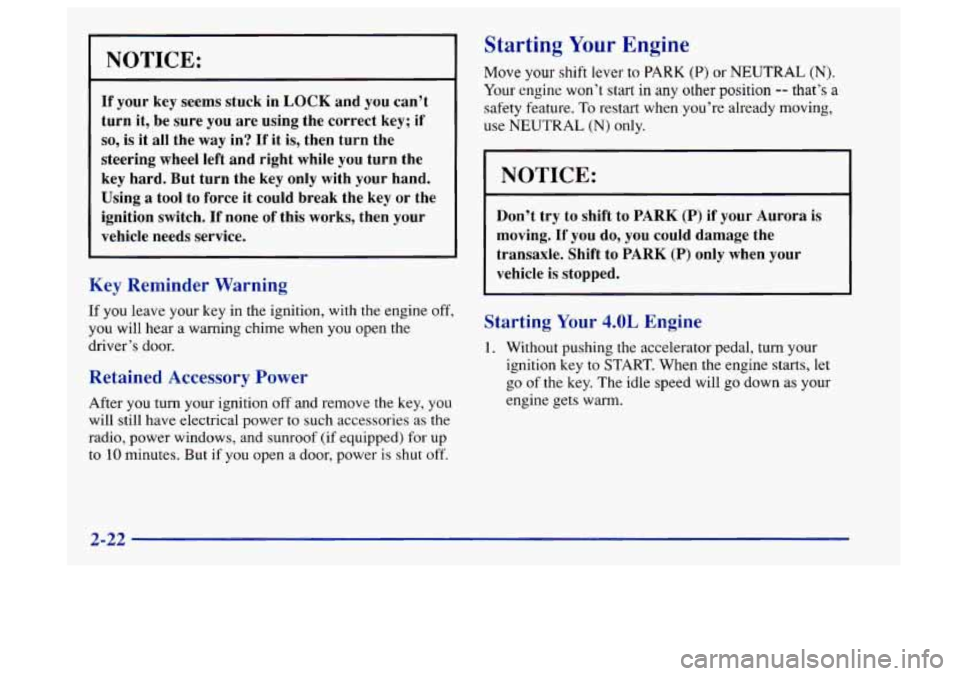
NOTICE:
If your key seems stuck in LOCK and you can’t
turn it, be sure you are using the correct key; if
so, is it all the way in? If it is, then turn the
steering wheel left and right while you turn the
key hard. But turn the key only with your hand.
Using
a tool to force it could break the key or the
ignition switch. If none
of this works, then your
vehicle needs service.
Key Reminder Warning
If you leave your key in the ignition, with the engine off,
you will hear a warning chime when you open the
driver’s door.
Retained Accessory Power
After you turn your ignition off and remove the key, you
will still have electrical power
to such accessories as the
radio, power windows, and sunroof
(if equipped) for up
to 10 minutes. But if you open a door, power is shut off.
Starting Your Engine
Move your shift lever tu PARK (P) or NEUTRAL (N).
Your engine won’t start in any other position -- that’s a
safety feature. To restart when you’re already moving,
use NEUTRAL
(N) only.
I NOTICE:
Don’t try to shift to PARK (P) if your Aurora is
moving. If you do, you could damage the
transaxle. Shift to PARK
(P) only when your
vehicle is stopped.
Starting Your 4.0L Engine
1. Without pushing the accelerator pedal, turn your
ignition key to START. When the engine starts, let
go of the key.
The idle speed will go down as your
engine gets warm.
2-22
Page 79 of 404
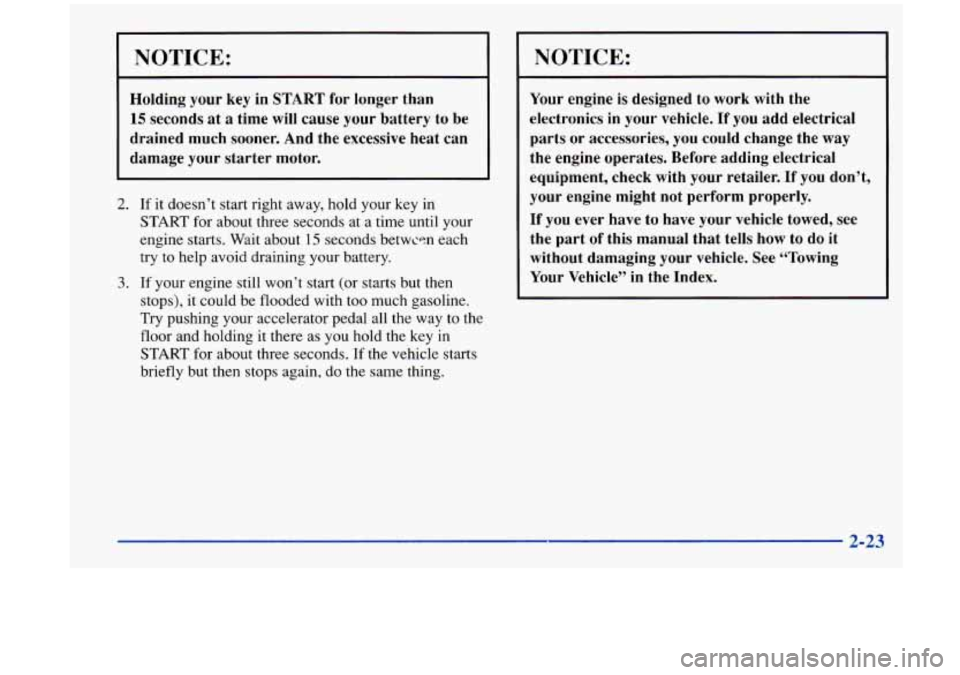
NOTICE:
Holding your key in START for longer than
15 seconds at a time will cause your battery to be
drained much sooner. And the excessive heat can
damage your starter motor.
2. If it doesn’t start right away, hold your key in
START for about three seconds at a time until your
engine starts. Wait about
15 seconds betwcsn each
try to help avoid draining your battery.
3. If your engine still won’t start (or starts but then
stops),
it could be flooded with too much gasoline.
Try pushing your accelerator pedal all the way to the
floor and holding
it there as you hold the key in
START for about three seconds. If
the vehicle starts
briefly but then stops again,
do the same thing.
NOTICE:
Your engine is designed to work with the
electronics
in your vehicle. If you add electrical
parts
or accessories, you could change the way
the engine operates. Before adding electrical
equipment, check with your retailer. If you don’t,
your engine might not perform properly.
If you ever have to have your vehicle towed, see
the part of this manual that tells how to do it
without damaging your vehicle. See “Towing
Your Vehicle” in the Index.
2-23
Page 82 of 404
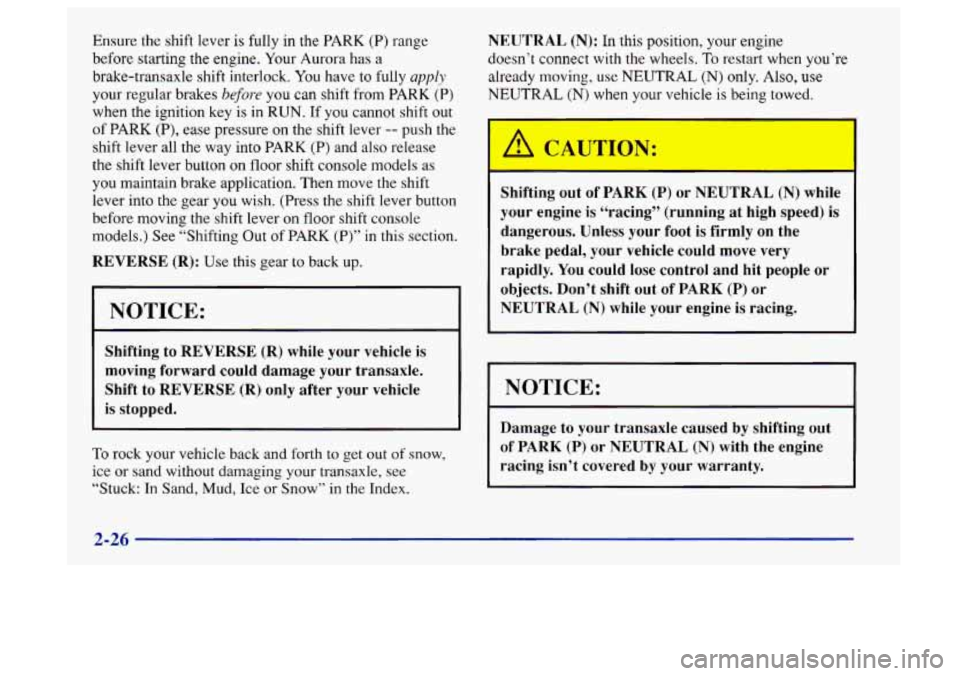
Ensure the shift lever is fully in the PARK (P) range
before starting the engine. Your Aurora has a
brake-transaxle shift interlock. You have to fully
apply
your regular brakes before you can shift from PARK (P)
when the ignition key is in RUN. If you cannot shift out
of PARK (P), ease pressure on the shift lever -- push the
shift lever all the way into PARK
(P) and also release
the shift lever button on floor shift console models as
you maintain brake application. Then move the shift
lever into the gear you wish. (Press
the shift lever button
before moving the shift lever on floor shift console
models.) See “Shifting Out
of PARK (P)” in this section.
REVERSE (R): Use this gear to back up.
NOTICE:
Shifting to REVERSE (R) while your vehicle is
moving forward could damage your transaxle.
Shift to
REVERSE (R) only after your vehicle
is stopped.
To rock your vehicle back and
forth to get out of snow,
ice or sand without damaging your transaxle, see
“Stuck:
In Sand, Mud, Ice or Snow” in the Index.
NEUTRAL (N): In this position, your engine
doesn’t connect with the wheels.
To restart when you’re
already moving, use NEUTRAL
(N) only. Also, use
NEUTRAL (N) when your vehicle is being towed.
Shifting out
of PARK (P) or NEUTRAL (N) while
your engine is “racing” (running at high speed) is
dangerous. Unless your foot is firmly on the
brake pedal, your vehicle could move very
rapidly.
You could lose control and hit people or
objects. Don’t shift out of PARK (P) or
NEUTRAL (N) while your engine is racing.
I NOTICE:
Damage to your transaxle caused by shifting out
of PARK (P) or NEUTRAL (N) with the engine
racing isn’t covered by your warranty.
2-26
Page 86 of 404
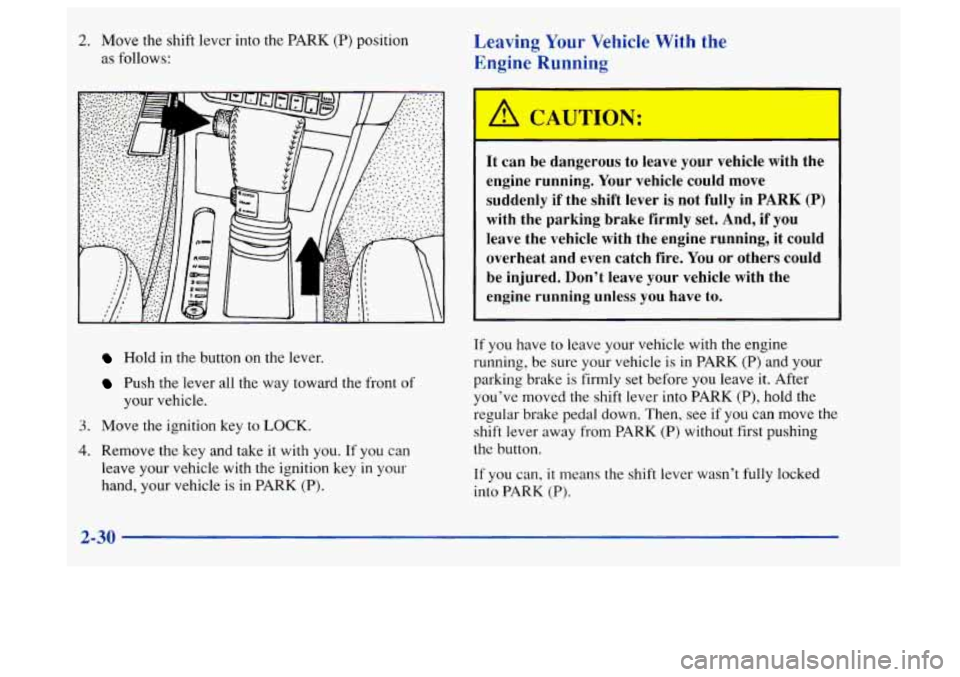
2. Move the shift lever into the PARK (P) position
as
follows:
Leaving Your Vehicle With the
Engine Running
It can be dangerous to leave your vehicle with the
engine running. Your vehicle could move
suddenly if the shift lever is not fully in PARK
(P)
with the parking brake firmly set. And, if you
leave the
ehicle with the engine running, it could
overheat and even catch fire.
You or others could
be injured. Don’t leave your vehicle with the
engine running unless you have to.
Hold in the button on the lever.
Push the lever all the way toward the front of
your vehicle.
3. Move the ignition key to LOCK.
4. Remove the key and take it with you. If you can
leave your vehicle with the ignition key
in your
hand, your vehicle is in PARK
(P).
If you have to leave your vehicle with the engine
running, be sure your vehicle is in PARK (P) and your
parking brake is firmly set before you leave it. After
you’ve moved the shift lever into PARK
(P), hold the
regular brake pedal down. Then, see if you can move the
shift lever away from PARK (P) without first pushing
the button.
If you can,
it means the shift lever wasn’t fully locked
into PARK
(P).
2-30
Page 87 of 404
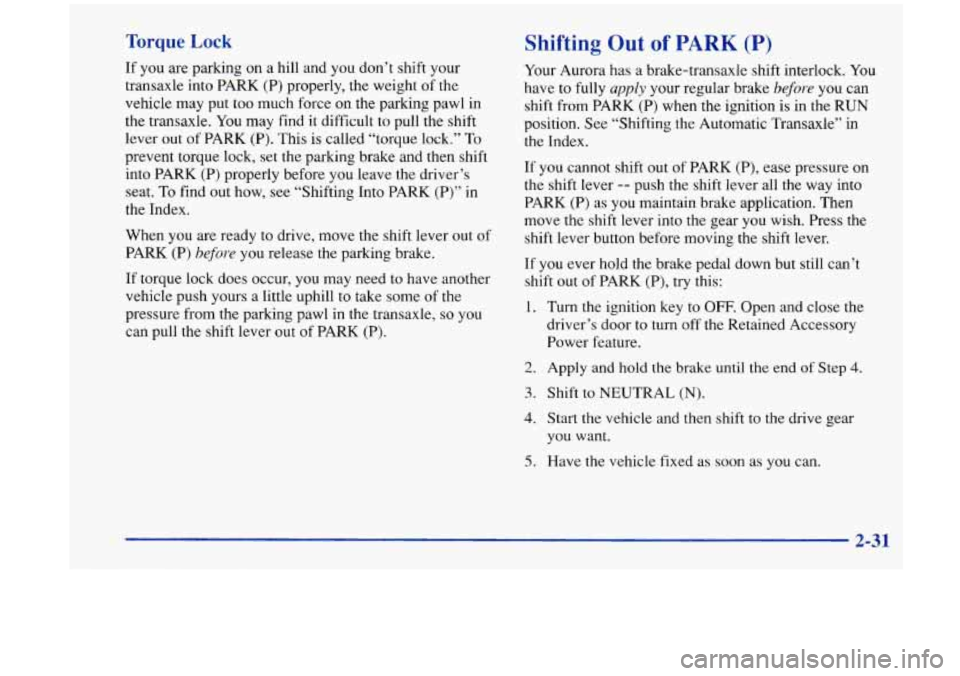
Torque Lock
If you are parking on a hill and you don’t shift your
transaxle into PARK (P) properly, the weight of the
vehicle may put too much force on the parking pawl in
the transaxle. You may find it difficult to pull the shift
lever out of PARK (P). This is called “torque lock.”
To
prevent torque lock, set the parking brake and then shift
into PARK (P) properly before you leave the driver’s
seat. To find out how,
see “Shifting Into PARK (P)” in
the Index.
When you are ready
to drive, move the shift lever out of
PARK (P)
before you release the parking brake.
If torque lock does occur, you may need to have another
vehicle push yours a little uphill to take some
of the
pressure from the parking pawl in the transaxle,
so you
can pull the shift lever out
of PARK (P).
Shifting Out of PARK (P)
Your Aurora has a brake-transaxle shift interlock. You
have
to fully apply your regular brake before you can
shift from PARK (P) when the ignition is
in the RUN
position. See “Shifting the Automatic Transaxle” in
the Index.
If you cannot shift out of PARK (P), ease pressure on
the shift lever
-- push the shift lever all the way into
PARK (P) as you maintain brake application. Then
move the shift lever into the gear you wish. Press the
shift lever button before moving the shift lever.
If you ever hold the brake pedal down but still can’t
shift out
of PARK (P), try this:
1.
2.
3.
4.
5.
Turn the ignition key to OFF. Open and close the
driver’s door to turn off
the Retained Accessory
Power feature.
Apply and hold the brake until
the end of Step 4.
Shift to NEUTRAL (N).
Start the vehicle and then shift to the drive gear
you want.
Have the vehicle fixed as
soon as you can.
2-31
Page 93 of 404
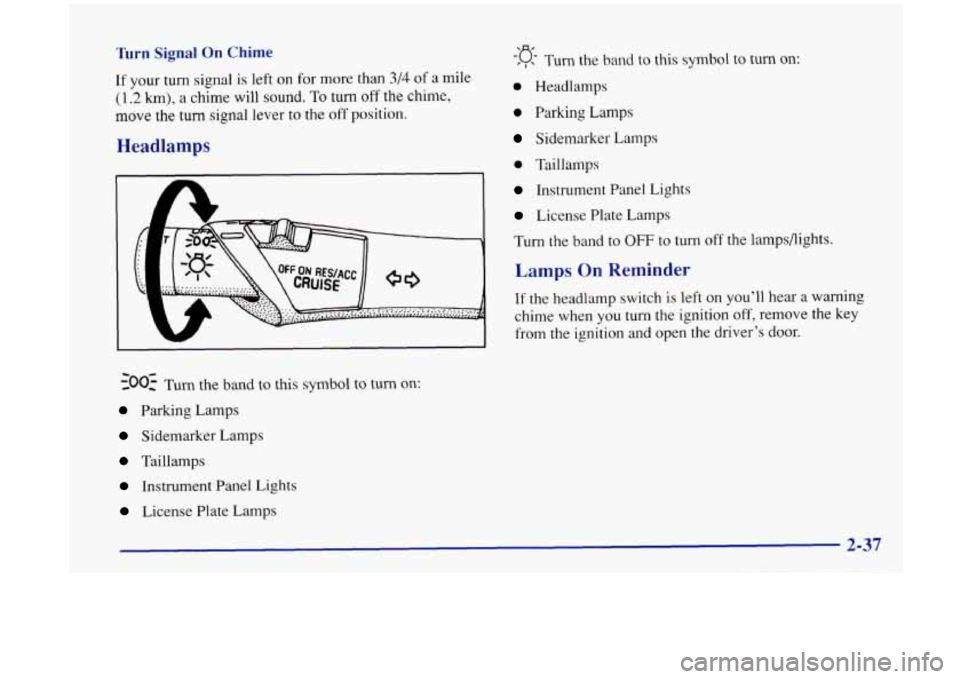
Turn Signal On Chime
If your turn signal is left on for more than 3/4 of a mile
(1.2 km), a chime will sound. To turn off the chime,
move the turn signal lever to the off position.
Headlamps
Turn the band to this symbol to turn on:
Parking Lamps
Sidemarker Lamps
Taillamps
Instrument Panel Lights
License Plate Lamps
-‘Q , , Turn the band to this symbol to turn on:
0 Headlamps
0 Parking Lamps
Sidemarker Lamps
0 Taillamps
Instrument Panel Lights
License Plate Lamps
Turn the band to
OFF to turn off the lampsflights.
Lamps On Reminder
If the headlamp switch is left on you’ll hear a warning
chime when you turn the ignition
off, remove the key
from the ignition and open the driver’s door.
Page 103 of 404
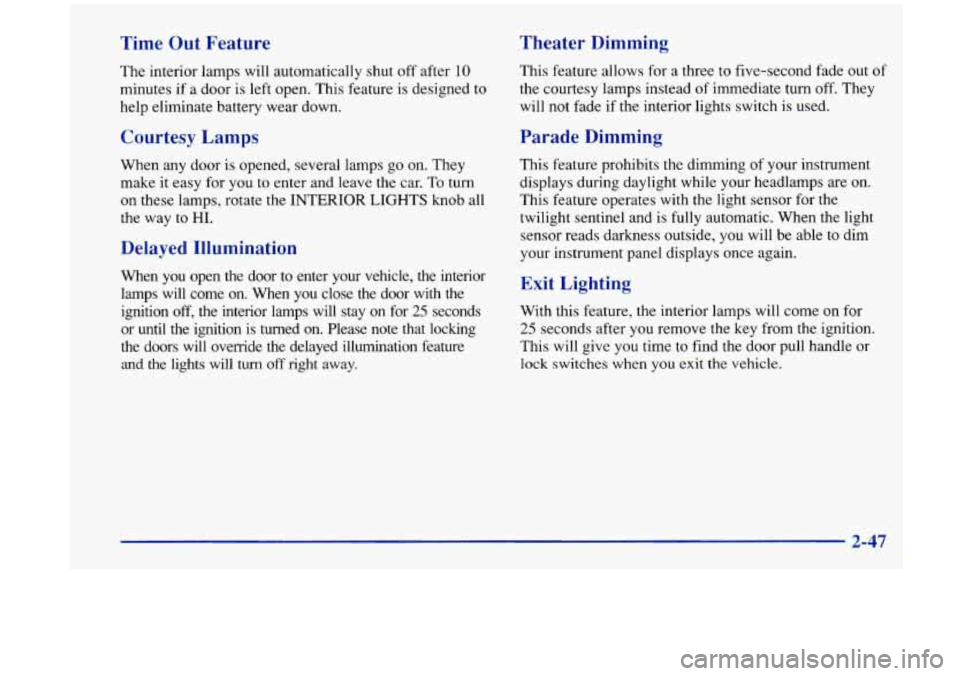
Time Out Feature Theater Dimming
The interior
lamps will automatically shut off after 10
minutes if a door is left open. This feature is designed to
help eliminate battery wear down.
Courtesy Lamps
When any door is opened, several lamps go on. They
make it easy for you to enter and leave the car. To turn
on these lamps, rotate the
INTERIOR LIGHTS knob all
the way to
HI.
Delayed Illumination
When you open the door to enter your vehicle, the interior
lamps will come on. When you close the door with the
ignition
off, the interior lamps will stay on for 25 seconds
or until the ignition is turned on. Please note that locking
the doors will override the delayed illumination feature
and the lights will turn off right away. This feature allows for
a three to five-second fade out
of
the courtesy lamps instead of immediate turn off. They
will not fade if the interior lights switch
is used.
Parade Dimming
This feature prohibits the dimming of your instrument
displays during daylight while your headlamps are on.
This feature operates with the light sensor for
the
twilight sentinel and is fully automatic. When the light
sensor reads darkness outside, you will be able to dim
your instrument panel displays once again.
Exit Lighting
With this feature, the interior lamps will come on for
25 seconds after you remove the key from the ignition.
This will give you time to find the door pull handle or
lock switches when you exit the vehicle.
2-47
Page 104 of 404
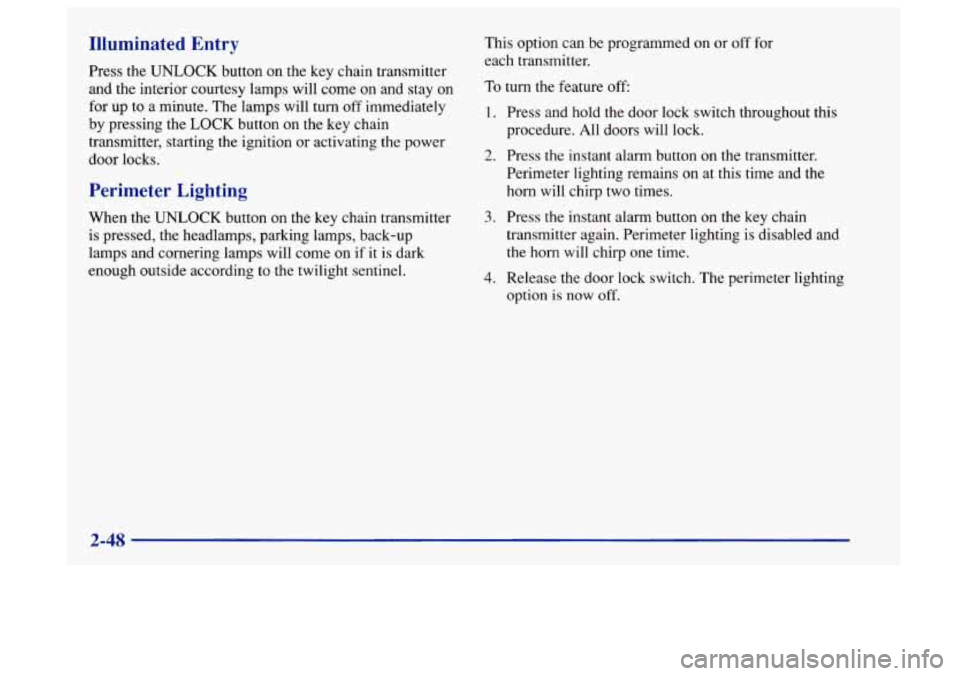
Illuminated Entry
Press the UNLOCK button on the key chain transmitter
and the interior courtesy lamps will come on and stay on
for up
to a minute. The lamps will turn off immediately
by pressing the
LOCK button on the key chain
transmitter, starting the ignition or activating the power
door locks.
Perimeter Lighting
When the UNLOCK button on the key chain transmitter
is pressed, the headlamps, parking lamps, back-up
lamps and cornering lamps will come on if it is dark
enough outside according to the twilight sentinel.
This option can be programmed on or off for
each transmitter.
To turn the feature off
1. Press and hold the door lock switch throughout this
procedure. All doors will lock.
2. Press the instant alarm button on the transmitter.
Perimeter lighting remains on at this time and the
horn will chirp two times.
3. Press the instant alarm button on the key chain
transmitter again. Perimeter lighting is disabled and
the horn will chirp one time.
4. Release the door lock switch. The perimeter lighting
option is now
off.
2-48
Page 105 of 404

To turn the feature on: Front Reading Lamps
1.
2.
3.
4.
Press and hold the door lock switch throughout this
procedure. All doors will lock.
Press the instant alarm button
on the key chain
transmitter. Perimeter lighting remains off at this
time and the
horn will chirp one time.
Press the instant alarm button on the transmitter
again. Perimeter lighting is now enabled and the
horn will chirp two times.
Release the door lock switch. The perimeter lighting
option is now on.
These lamps and the interior courtesy lamps will come
on when you open a door. They will turn off when you
turn on
the ignition. If the door is left open, they will
turn off after about
10 minutes.
To turn
on the reading lamps when the doors are closed,
press the button behind the lamp you want on. Press
it
again to turn the lamp off.
These lamps work even when the ignition is off. To avoid
draining your vehicle's battery, be sure to
turn off all front
and rear reading lamps when leaving your vehicle.
2-49
Page 110 of 404
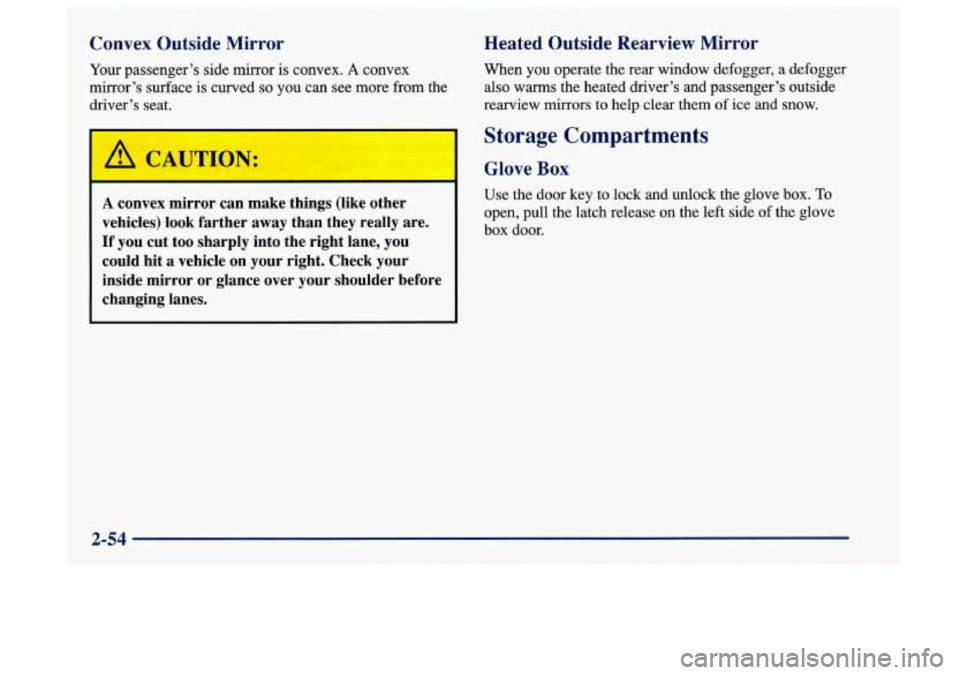
Convex Outside Mirror
Your passenger’s side mirror is convex. A convex
mirror’s surface is curved
so you can see more from the
driver’s seat.
I
A convex mirror can make things (like other
vehicles) look farther away than they really are.
If you cut too sharply into the right lane, you
could hit
a vehicle on your right. Check your
inside mirror or glance over your shoulder before
changing lanes.
Heated Outside Rearview Mirror
When you operate the rear window defogger, a defogger
also
warms the heated driver’s and passenger’s outside
rearview mirrors to help clear them
of ice and snow.
Storage Compartments
Glove Box
Use the door key to lock and unlock the glove box. To
open, pull the latch release on the left side of the glove
box door.
2-54